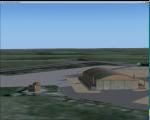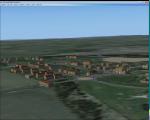0.03Mb (212 downloads)
RAF Strubby was located south east of the Lincolnshire Wolds town of Louth and south of the village from where the station got its name.
Opening in early 1944 the station lead a varied aircraft career being used by the USAAF as well as the RAF during the time it was operation. (For a more detailed history of the station the following web site is a wonderful source of information - www.bcar.org.uk/strubby-history. The station closed for Military flying in 1972. By Terry Boissel
Posted Dec 7, 2015 19:16 by Terry Boissel
0.01Mb (204 downloads)
RAF Stenigot was a Second World War radar station situated at Stenigot, near Donington on Bain, Lincolnshire.
It was part of the Chain Home radar network, intended to provide long range early warning for raids from
Luftflotte V and the northern elements of Luftflotte II along the approaches to Sheffield and Nottingham and the
central midlands.
After the Second World War, the site was retained as part of the Chain Home network. In 1959 it was upgraded to a
communications relay site as part of the ACE High program, which involved adding four tropospheric scatter dishes.
The site was decommissioned in the late 1980s and was mostly demolished by 1996.
The radar tower is a Grade II listed structure and is now used by the RAF Aerial Erector School for selection
tests for possible recruits.
There is a Memorial at the top to a former RAF Aerial Erector.
Souce: Wikipedia
Posted Dec 7, 2015 19:13 by Terry Boissel


55.01Mb (1609 downloads)
FSX Massarotti (Caltagirone) Airfield, Catania, Scicily photoreal scenery. The airfield supports flight operations and skydiving and offers catering and accommodation.
Features: Massarotti Airfield has a grass or clay runway depending on the season. Documents included. Nunzio Caltabiano. Updated and fixed as some users reported crash.
Posted Dec 7, 2015 06:33 by Voyager

0.85Mb (610 downloads)
This update adds numerous visual details to the area around the airport as well as the addition of more roads to the island. Namely, the approach lights to runway 12 are corrected to appear on pylons and at runway elevation. This update requires "Rodrigues_Island.zip".
Required files:
required file
Posted Dec 7, 2015 03:14 by Carlyle Sharpe


1.27Mb (292 downloads)
Royal Air Force Ouston,is a former Royal Air Force station that was located near the village of Stamfordham and
the village of Heddon-on-the-Wall on Hadrian's Wall near Newcastle upon Tyne. The station opened on the 10 March
1941 and closed for flying in September 1974. As with many airfields the Army moved in and the station was re-
named Albemarle barracks.
If you would like the full history of the station or any other station in the North East I recommend you go to
the"North East Avation Research" website the link is:-
http://www.nelsam.org.uk/NEAR/Airfields/Histories/Ouston.htm
Posted Dec 6, 2015 19:06 by Terry Boissel
0.02Mb (280 downloads)
RAF Hibaldstow is a former Royal Air Force satellite airfield located south of Hibaldstow in Lincolnshire and 8.3 miles (13.4 km) south east of Scunthorpe, Lincolnshire, England.
The airfield was built with greater things in mind, but it only became a satellite airfield for RAF Kirton-in-Lindsey in 1941. When the runways were constructed, some of the hardcore was made from material taken from demolished bungalows on the site.
The airfield was commissioned on 12 May 1941 when No. 255 Squadron RAF took up residence with their Boulton Paul Defiant night fighters. These planes had been drawn from RAF Kirton-in-Lindsey and made one 'kill': an He 111 which was shot down near Louth on 5 June 1941.
In June 1941 the Defiants were replaced by Bristol Beaufighter IIFs and on 23 September 1941 No. 253 (Hyderabad) Squadron from RAF Skeabrea, Orkney, arrived. In addition Havocs from RAF Hunsdon in Hunsdon, Hertfordshire also came to the base.
By the start of 1943, the high risk of night attacks by the Luftwaffe led to the closure of the airfield on 23 January 1943. It re-opened on 9 May 1943 for No. 53 Operational Training Unit RAF (OTU) and once again closed on 15 May 1945. Shortly before closure WAAF Margaret Horton had an 'unexpected ride on the tail of a Supermarine Spitfire' while acting as a tailweight: she was sitting on the tail of the plane, as was common practice, in order to stop it overturning while it taxied to the end of the runway, a hazard stemming from design drawbacks, strong wind and bouncy grass field. The pilot, anxious to be airborne, forgot about her and failed to stop to allow the WAAF to jump off the tail. As soon as the plane was in the air, the pilot realised that there was something very wrong with the handling of his aircraft. He radioed the control tower to report the problem. The emergency services were called out and the pilot talked back in without being told what had happened. The aircraft landed safely with Margaret Horton still in one piece.
On 6 August 1947 the station finally closed and during 1960-61 it was sold off for use as agricultural land. It was also used for Sunday markets, as a skid-pan by Lincolnshire Police and by a local parachute club. The control tower was converted to a two-storey house in 1976.
Source Wikipedia
Posted Dec 6, 2015 18:29 by Terry Boissel
0.02Mb (239 downloads)
RAF Kirton in Lindsey was a Royal Air Force installation located 15 miles (24 km) north of Lincoln, Lincolnshire, England.
From the historical point of view, there is some uncertainty about the correct name of the location. Kirton Lindsey or Kirton-in-Lindsey?
It appears to have been an RAF habit (inherited from the RFC to name its bases after the nearest railway station, possibly to simplify the process of issuing Rail Warrants to personnel posted there. By that token, the site should be RAF Kirton Lindsey, Kirton Lindsey being the name of the nearby railway station constructed in 1849. No.255 Squadron's Operations Record Book (ORB) consistently uses that version of the name. So does the airfield's separate ORB, from the date of the site's WWII creation (15 May 1940) through to May 1941. After mid-1941 and the departure of No.255 Squadron, use of RAF Kirton-in-Lindsey. Kirton in Lindsey begins to appear in the site's own records - eventually dominating. By Terry Boissel
Posted Dec 6, 2015 14:31 by Terry Boissel
0.02Mb (282 downloads)
RAF Woodhall Spa is a former Royal Air Force station located 2 miles (3.2 km) north of Coningsby, Lincolnshire and
16 miles (26 km) south east of Lincoln, Lincolnshire, England.
Constructed on farmland 1.2 miles (1.9 km) south of Woodhall Spa, the station opened in February 1942 as a
satellite station to RAF Coningsby. In August 1943 it became No. 54 Base Substation. After victory in Europe the
airfield was used as an assembly and kitting out point for Tiger Force (a proposed heavy bomber force for the far
east). After the end of the Second World War and with the move of No. 617 Squadron RAF to RAF Waddington the
airfield was closed and the site used by No. 92 Maintenance Unit for the storage of bombs. From the late 1950s it
was used as a base for Bristol Bloodhound Missiles until 1964 when most of the site was sold off for agriculture
or mineral extraction. The former missile site used to be under the control of RAF Coningsby having been used for
the servicing of McDonnell Douglas Phantom and Panavia Tornado aircraft engines until finally being mothballed in
2003.
Posted Dec 6, 2015 09:27 by Terry Boissel
0.02Mb (275 downloads)
RAF Little Rissington (ICAO: EGVL) is an RAF aerodrome and former RAF station in Gloucestershire, England. It was once home to the Central Flying School, the Vintage Pair and the Red Arrows.
Built during the 1930s, the station was opened in 1938 and closed in 1994. The married-quarters and main technical site were sold in 1996 (the former becoming the village of Upper Rissington), but the aerodrome has been retained by the Ministry of Defence and remains active along with the southern technical sites, under the operational control of HQ No.2 Flying Training School at RAF Syerston.
It is now home to 637 Volunteer Gliding Squadron as the primary military unit, who provide elementary flying training for Combined Cadet Force and Air Training Corps cadets. The airfield is also used by the forces as a relief landing ground, training area and parachute dropping area. In previous years, the Royal Air Force estate has been used as a film set, including The Avengers, part of the ice chase in Die Another Day, and the Thunderbirds film
Souce: Wikipedia
Posted Dec 6, 2015 08:25 by Terry Boissel
0.01Mb (235 downloads)
RAF Folkingham is a former Royal Air Force station located south west of Folkingham, Lincolnshire and about 29 miles (47 km) due south of county town Lincoln and 112 miles (180 km) north of London, England.
Opened in 1940, it was used by both the Royal Air Force and United States Army Air Forces. During the war it was used primarily as a troop carrier airfield for airborne units and as a subsidiary training depot of the newly formed Royal Air Force Regiment. After the war it was placed on care and maintenance during 1947 when the RAF Regiment relocated to RAF Catterick.
During the late 1950s and early 1960s, the RAF Bomber Command used Folkingham as a PGM-17 Thor Intermediate Range Ballistic Missile (IRBM) base.
Today the remains of the airfield are located on private property being used as agricultural fields, with the main north-south runway acting as hardstanding for hundreds of scrapped vehicles
Souce: Wikipedia
Posted Dec 6, 2015 08:22 by Terry Boissel


